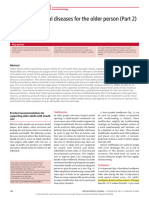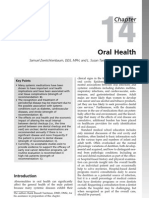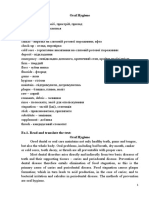0 ratings0% found this document useful (0 votes)
24 viewsWhat Does Perio Treatment Involve
What Does Perio Treatment Involve
Uploaded by
Gabriela ArgeseanuCopyright:
© All Rights Reserved
Available Formats
Download as PDF, TXT or read online from Scribd
What Does Perio Treatment Involve
What Does Perio Treatment Involve
Uploaded by
Gabriela Argeseanu0 ratings0% found this document useful (0 votes)
24 views2 pagesOriginal Title
What_does_perio_treatment_involve
Copyright
© © All Rights Reserved
Available Formats
PDF, TXT or read online from Scribd
Share this document
Did you find this document useful?
Is this content inappropriate?
Copyright:
© All Rights Reserved
Available Formats
Download as PDF, TXT or read online from Scribd
Download as pdf or txt
0 ratings0% found this document useful (0 votes)
24 views2 pagesWhat Does Perio Treatment Involve
What Does Perio Treatment Involve
Uploaded by
Gabriela ArgeseanuCopyright:
© All Rights Reserved
Available Formats
Download as PDF, TXT or read online from Scribd
Download as pdf or txt
You are on page 1of 2
Patient Periodontal
The most common procedures involved Information Leaflet No. 3
in periodontal treatment are scaling
and root planing.
Scaling involves removal of plaque and calculus deposits
that are visible above and just below the gum line on the
root of the tooth. Your dental professional may use an
ultrasonic cleaning device or hand instruments to do this.
Root planing is a more time consuming procedure that
involves scraping and smoothing the root surfaces of your
teeth. Gum tissues can more firmly reattach to roots that
are clean and smooth.
Figure 4. Scaling Figure 5. Root Planing
For further enquiries
Dental Practice Education Research Unit
ARCPOH, School of Dentistry
Quitting Smoking The University of Adelaide, SA 5005
Smoking increases the risk of having more rapidly
Phone: +61 8 8313 6084
destructive periodontal disease. It also places you at Fax: +61 8 8313 4858
risk of mouth cancers. If you are a smoker, your dental Online enquiries: arcpoh.adelaide.edu.au/dperu
professional will probably advise you on the availability of
“quit-smoking” programs and materials.
Gum Disease
adelaide.edu.au
facebook.com/uniofadelaide
Australia Quitline: 137 848 (13 QUIT)
twitter.com/uniofadelaide
New Zealand Quitline: 0800 778 778 youtube.com/universityofadelaide
What does periodontal
treatment involve?
Disclaimer: The information in this publication is current as at the date of printing and is
Your dental professional may refer you
subject to change. You can find updated information on our website at adelaide.edu.au
With the aim of continual improvement the University of Adelaide is committed to regular
reviews of the degrees, diplomas, certificates and courses on offer. As a result the specific
to a periodontist – a specialist in gum programs and courses available will change from time to time. Please refer to adelaide.edu.au
for the most up to date information or contact us on 1800 061 459. The University of Adelaide
diseases. assumes no responsibility for the accuracy of information provided by third parties.
CRICOS 00123M © The University of Adelaide. Published Oct 2015
Acknowledgement:
Colgate Periodontal Education Program | Colgate Oral Care
Periodontal treatment is care that The type of periodontal treatment needed will vary according Oral hygiene instruction
to the severity of your gum problem. Different aspects of
your dental professional undertakes to treatment, and the time it is likely to take, will be explained The first goal of oral hygiene instruction is to improve your
ensure you have healthy gums. by your dental professional. The treatment plan is usually ability to remove plaque from your teeth. Your dental
adapted to fit with other dental treatment you may require. professional will assist you with the correct techniques for
Periodontal treatment is designed brushing and flossing your teeth.
specifically for your level of gum Figure 2. Mouth with severe periodontal disease
Other home aids may be suggested to help control plaque
disease. build-up, such as mouth-rinses, floss, inter-dental tooth
brushes, toothpastes and disclosing solutions. Instruction
Periodontal disease involves destruction of tooth-supporting will be given on their use, and how often they should be
tissues (bone and gum). It occurs in a cyclic manner, with used to be effective.
bursts of destruction and periods of inactivity. Figure 3. Dental
products that help
improve oral hygiene
Periodontal treatment aims to:
> remove the irritants that may be associated with the active
destructive phase of the disease.
> maintain your gum tissues to prevent further destruction.
> advise you how to keep your gums as healthy as possible.
What does periodontal treatment
Figure 1. Periodontal disease showing loss of bone
involve?
A plan for periodontal treatment involves the development
of an ordered sequence of dental procedures which will be
undertaken to restore your teeth and gums to health.
This plan will organise the different treatments to be used into
a specific order to get the best results.
Filling replacement
Periodontal treatment usually involves oral hygiene instruction
Some of your fillings and crowns may be contributing to the
and removal of plaque and calculus build-up. It may also
inflammation of your gums. These may need to be reshaped
involve a review of medical conditions, filling replacement and
or replaced to provide surfaces that are easier to keep clean.
The success of periodontal treatment is largely due to the advice to assist with smoking cessation.
effort you as an individual make to remove the daily build-up Figure 6. Fillings or
crowns may need to be
of plaque from tooth and gum surfaces. To prevent and help
heal inflamed gums, it is essential to control plaque build-up. Removal of plaque and calculus smoothed or replaced
build-up Areas where plaque
may accumulate
Your dental professional will remove plaque and calculus
You are the person who plays the most that has built up over a period of time. Plaque is a sticky,
important role in your periodontal colourless film of bacteria that builds up on the teeth and is
treatment. the major cause of gingivitis and periodontitis. Calculus is
plaque that has hardened over time (often called “tartar”).
You might also like
- MCQ OrthoDocument45 pagesMCQ OrthodentistsurorNo ratings yet
- Textbook of Orthodontics - Samir Bishara - 599 - 52MBDocument599 pagesTextbook of Orthodontics - Samir Bishara - 599 - 52MBPratyusha Vallam96% (45)
- Written Caries Case StudyDocument16 pagesWritten Caries Case Studyapi-547172617No ratings yet
- Perio EssayDocument7 pagesPerio Essayapi-252614255No ratings yet
- PD CAT2019 CatalogueProduits E 191119 TempDocument98 pagesPD CAT2019 CatalogueProduits E 191119 TempchimedbatorNo ratings yet
- By Mayo Clinic Staff: Click To EnlargeDocument4 pagesBy Mayo Clinic Staff: Click To EnlargeLexie DvrelsNo ratings yet
- Patient 08 PDFDocument1 pagePatient 08 PDFamarNo ratings yet
- Ultrasonic Scaling Before Tooth Brushing PDFDocument4 pagesUltrasonic Scaling Before Tooth Brushing PDFSarra TekayaNo ratings yet
- Prevention of Gum Disease: Your Oral HealthDocument3 pagesPrevention of Gum Disease: Your Oral HealthmebibegNo ratings yet
- Treating Periodontal Diseases: For The Dental Patient ..Document1 pageTreating Periodontal Diseases: For The Dental Patient ..damien.thorn4294No ratings yet
- Prevention of Gum Disease: Diabetes and Your Oral HealthDocument3 pagesPrevention of Gum Disease: Diabetes and Your Oral HealthmebibegNo ratings yet
- Presentation 1. Treatment Planning For The Immediate Denture 2. The Patient With Periodontal DiseaseDocument19 pagesPresentation 1. Treatment Planning For The Immediate Denture 2. The Patient With Periodontal DiseaseNika Permata DelaNo ratings yet
- Research Paper On TeethDocument6 pagesResearch Paper On Teethixevojrif100% (1)
- Bio Dental Project Grade 12thDocument30 pagesBio Dental Project Grade 12thaaynjig37No ratings yet
- Prevention of Oral Diseases For The Older Person (Part 2) : ClinicalDocument5 pagesPrevention of Oral Diseases For The Older Person (Part 2) : ClinicalFatima AliNo ratings yet
- ProDentim Review - How To Cure Gum Disease ?: How To Cure Tooth Decay Naturally....!!From EverandProDentim Review - How To Cure Gum Disease ?: How To Cure Tooth Decay Naturally....!!No ratings yet
- Dental Care and Oral HealthDocument13 pagesDental Care and Oral HealthNasroNo ratings yet
- m71019 - Ingles I Cuadernillo Guia Odontologia I - 2020Document8 pagesm71019 - Ingles I Cuadernillo Guia Odontologia I - 2020Jennifer MezaNo ratings yet
- Dental Assistant Research PaperDocument6 pagesDental Assistant Research Paperkiitoaulg100% (1)
- Iwst10 IktDocument6 pagesIwst10 Ikt9bgnyshtbhNo ratings yet
- In The Dental Implant Era, Why Do We Still Bother Saving Teeth?Document8 pagesIn The Dental Implant Era, Why Do We Still Bother Saving Teeth?Gabriela ArgeseanuNo ratings yet
- m71019 - Ingles I GuiasDocument8 pagesm71019 - Ingles I GuiasJennifer MezaNo ratings yet
- Dental Health EbookDocument15 pagesDental Health EbooktmetscherNo ratings yet
- Аяна, Инглиш, Сессия ОтветыDocument7 pagesАяна, Инглиш, Сессия Ответыcf2wts9zxmNo ratings yet
- Research Paper On DentistryDocument8 pagesResearch Paper On Dentistryvrxhvexgf100% (1)
- Periodontics: PeriodontitisDocument6 pagesPeriodontics: PeriodontitismarkoNo ratings yet
- CD CareDocument8 pagesCD CareAkshayNo ratings yet
- Salud PDFDocument16 pagesSalud PDFDulce MartinezNo ratings yet
- Marketing DentistryDocument3 pagesMarketing DentistryleonelrochaNo ratings yet
- Rguhs Thesis Topics in Public Health DentistryDocument7 pagesRguhs Thesis Topics in Public Health Dentistryzidhelvcf100% (2)
- Secrets Your Dentist Doesn't Want You To KnowDocument6 pagesSecrets Your Dentist Doesn't Want You To Knowscott38w2727No ratings yet
- Edt 12576-1Document17 pagesEdt 12576-1Per TobNo ratings yet
- Dental Hygiene Dissertation TopicsDocument7 pagesDental Hygiene Dissertation TopicsIWillPayYouToWriteMyPaperUK100% (1)
- Dental Hygiene and Periodontal DiseaseDocument7 pagesDental Hygiene and Periodontal Diseaseapi-536835901No ratings yet
- Endodontist or Dentist - Which Makes The Right Choice?Document2 pagesEndodontist or Dentist - Which Makes The Right Choice?Tarun KumarNo ratings yet
- Perio Caries Recommendations01 Oralhealthteam DEC2021 1Document8 pagesPerio Caries Recommendations01 Oralhealthteam DEC2021 1ioana zaineaNo ratings yet
- Cover Front Cover: 0eriodontal 'Um $iseaseDocument16 pagesCover Front Cover: 0eriodontal 'Um $iseaseam31_applezNo ratings yet
- 3 Consequences ENDocument11 pages3 Consequences ENFrancisco AntónioNo ratings yet
- BDJ Team - Managing Caries in Primary TeethDocument8 pagesBDJ Team - Managing Caries in Primary TeethJawad TariqNo ratings yet
- Definition GingivitisDocument7 pagesDefinition GingivitisverenNo ratings yet
- Pediatric Dental TraumaDocument11 pagesPediatric Dental TraumaDrBhawna AroraNo ratings yet
- Young Dentist August13Document3 pagesYoung Dentist August13RusevNo ratings yet
- Oral Health: Samuel Zwetchkenbaum, DDS, MPH, and L. Susan Taichman, RDH, MPH, PHDDocument20 pagesOral Health: Samuel Zwetchkenbaum, DDS, MPH, and L. Susan Taichman, RDH, MPH, PHDwesamkhouriNo ratings yet
- Perio Paper 1Document9 pagesPerio Paper 1api-733563770No ratings yet
- Pamantasan NG Lungsod NG MaynilaDocument15 pagesPamantasan NG Lungsod NG MaynilaAlex HollandNo ratings yet
- Research Paper On Dental AssistantDocument8 pagesResearch Paper On Dental Assistanthgrmzbikf100% (3)
- Oral HygieneDocument4 pagesOral HygieneНаталя ГодованецьNo ratings yet
- Dental ProductsDocument17 pagesDental Productsade safitri100% (1)
- Implant Book PDFDocument56 pagesImplant Book PDFayman75% (4)
- International Association of Dental Traumatology Guidelines For The Management of Traumatic Dental Injuries: 3. Injuries in The Primary DentitionDocument44 pagesInternational Association of Dental Traumatology Guidelines For The Management of Traumatic Dental Injuries: 3. Injuries in The Primary DentitionaNo ratings yet
- GINGIVITISDocument43 pagesGINGIVITISRamyaNo ratings yet
- Dental Trauma GuidelinesDocument16 pagesDental Trauma GuidelinesKhushbu AggarwalNo ratings yet
- Informed Consent ORTHO TestDocument4 pagesInformed Consent ORTHO TestjohnpurdellNo ratings yet
- Oral Surgery 14874Document4 pagesOral Surgery 14874StanislavNemtanuNo ratings yet
- ADA PatientSmart Preventing Perio PDFDocument4 pagesADA PatientSmart Preventing Perio PDFJoe WattimenaNo ratings yet
- Evaluation of The Periodontal Status of Abutment Teeth in Removable Partial DenturesDocument7 pagesEvaluation of The Periodontal Status of Abutment Teeth in Removable Partial DenturesGhina AdilahNo ratings yet
- Policy On The Use of Dental Bleaching For Child and Adolescent PatientsDocument4 pagesPolicy On The Use of Dental Bleaching For Child and Adolescent PatientsFebriani SerojaNo ratings yet
- Dental AidDocument6 pagesDental AidCroitort530% (1)
- Asds 07 1679Document4 pagesAsds 07 1679Abdulla Al-keklyNo ratings yet
- As Additives In: Making ToothpasteDocument26 pagesAs Additives In: Making ToothpasteJocelyn NagalizaNo ratings yet
- Unit 1 Clinical Dentistry 03.09.2023Document11 pagesUnit 1 Clinical Dentistry 03.09.2023Andrea DolganiucNo ratings yet
- IADT Guidelines 2020 - Injuries in The Primary Dentition PDFDocument17 pagesIADT Guidelines 2020 - Injuries in The Primary Dentition PDFrlahsenmNo ratings yet
- Local Drug Delivery of Herbs For Treatment of PeriodontitisDocument7 pagesLocal Drug Delivery of Herbs For Treatment of PeriodontitisplsssssNo ratings yet
- Endo-Perio Lesions Diagnosis and InterdisciplinaryDocument5 pagesEndo-Perio Lesions Diagnosis and InterdisciplinaryGabriela ArgeseanuNo ratings yet
- Clinical and Radiographic Evaluation of The Periodontium With Biologic Width Invasion by Overextending Restoration Margins - A Pilot StudyDocument7 pagesClinical and Radiographic Evaluation of The Periodontium With Biologic Width Invasion by Overextending Restoration Margins - A Pilot StudyGabriela ArgeseanuNo ratings yet
- Perio TreatmentDocument15 pagesPerio TreatmentGabriela ArgeseanuNo ratings yet
- Implementingsocketsealsurgery JP2008Document11 pagesImplementingsocketsealsurgery JP2008Gabriela ArgeseanuNo ratings yet
- In The Dental Implant Era, Why Do We Still Bother Saving Teeth?Document8 pagesIn The Dental Implant Era, Why Do We Still Bother Saving Teeth?Gabriela ArgeseanuNo ratings yet
- Ghid PracticaDocument36 pagesGhid PracticaGabriela ArgeseanuNo ratings yet
- Tord Berglundh: AuthorDocument9 pagesTord Berglundh: AuthorGabriela ArgeseanuNo ratings yet
- Søren Jepsen: AuthorDocument9 pagesSøren Jepsen: AuthorGabriela ArgeseanuNo ratings yet
- Partial Dentures PDFDocument1 pagePartial Dentures PDFGabriela ArgeseanuNo ratings yet
- Zygoma Brochure Rev 2017 1 enDocument24 pagesZygoma Brochure Rev 2017 1 enLê Minh KhôiNo ratings yet
- Laminates 1Document25 pagesLaminates 1Pooja ChaturvediNo ratings yet
- PREPROSTHETIC SURGERY - RamonDocument49 pagesPREPROSTHETIC SURGERY - Ramonjamaica faith ramonNo ratings yet
- Journal Ortho 4Document8 pagesJournal Ortho 4ClaudiaKaterineNo ratings yet
- English AJODO 2004Document3 pagesEnglish AJODO 2004Diego Andres Hincapie HerreraNo ratings yet
- Mandibular Second MolarDocument18 pagesMandibular Second MolarSushmitKojuNo ratings yet
- Perio Study GuideDocument8 pagesPerio Study Guidepreet sandhuNo ratings yet
- AngalbaDocument1 pageAngalbaHarish KhundrakpamNo ratings yet
- AIPGE Dental Paper of MDSDocument34 pagesAIPGE Dental Paper of MDSMohit ChandraNo ratings yet
- Pre Eruptive Intracoronal ResortionDocument5 pagesPre Eruptive Intracoronal ResortionAndres Mera VergaraNo ratings yet
- Management of Anterior Cross Bite in Mixed Dentition Using Catlan's ApplianceDocument4 pagesManagement of Anterior Cross Bite in Mixed Dentition Using Catlan's ApplianceRati Ramayani AbidinNo ratings yet
- Assessment Tool 10-26-2021Document17 pagesAssessment Tool 10-26-2021Aroroy RHUNo ratings yet
- Facial MidlineDocument5 pagesFacial MidlineNahid zafarNo ratings yet
- Clasificacion Estetica Dental AlteradaDocument11 pagesClasificacion Estetica Dental AlteradaAdrian Venegas MeloNo ratings yet
- Implant ComplicationsDocument15 pagesImplant ComplicationsDhanasriNo ratings yet
- Visagism: The Art of Dental CompositionDocument14 pagesVisagism: The Art of Dental CompositionCarolina AbadNo ratings yet
- A Systematic Review and Meta Analysis of The Attachments Used in Implant Supported OverdenturesDocument14 pagesA Systematic Review and Meta Analysis of The Attachments Used in Implant Supported OverdenturesDr FarhatNo ratings yet
- Estetica E30Document40 pagesEstetica E30the doctorNo ratings yet
- OP & Dento Skeletal Frames During Growth by Dr. Eliana Midori TanakaDocument11 pagesOP & Dento Skeletal Frames During Growth by Dr. Eliana Midori TanakaMarisol 'VelaNo ratings yet
- KulPak 15 - Tooth Discoloration - 1 (Treatment)Document4 pagesKulPak 15 - Tooth Discoloration - 1 (Treatment)Geubrina FitrianandaNo ratings yet
- Ace TechniqueDocument1 pageAce TechniqueXiid DNo ratings yet
- Third MolarDocument19 pagesThird MolarMike LimNo ratings yet
- IFU JonesJig Inst ENGDocument1 pageIFU JonesJig Inst ENGnomanNo ratings yet
- Maxillary Canine-First Premolar TranspositionDocument9 pagesMaxillary Canine-First Premolar TranspositionFabian BarretoNo ratings yet
- Perio Case StudyDocument17 pagesPerio Case Studyapi-544634047No ratings yet
- The Application of Microscopic Surgery in DentistryDocument6 pagesThe Application of Microscopic Surgery in DentistryArenas Ruiz KarinaNo ratings yet
- School Health Cards and FormsDocument8 pagesSchool Health Cards and FormsMisha Madeleine GacadNo ratings yet
- Khodayari, 2011Document5 pagesKhodayari, 2011KharismaNisaNo ratings yet


































































































